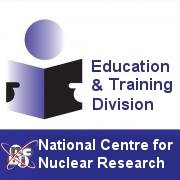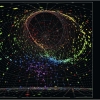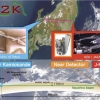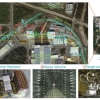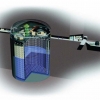T2K presents hint of CP violation by neutrinos
2017.08.03 20:46 - Marek PawłowskiT2K COLLABORATION ANNOUNCEMENT
The international T2K Collaboration strengthened its previous hint that the symmetry between matter and antimatter may be violated for neutrino oscillation. A preliminary analysis of T2K’s latest data rejects the hypothesis that neutrinos and antineutrinos oscillate with the same probability at 95% confidence (2σ) level. With nearly twice the neutrino data in 2017 compared to their 2016 results, T2K has performed a new analysis of neutrino and antineutrino data using a new event reconstruction algorithm for interactions in the far detector, Super-Kamiokande. Today’s announcement was made by Prof Mark Hartz, of the University of Tokyo Kavli Institute for the Physics and Mathematics of the Universe (Japan) and TRIUMF (Canada), who presented the results at a colloquium at the High Energy Accelerator Research Organization (KEK) in Tsukuba, Japan.
Why the universe is primarily comprised of matter today, instead of being comprised of equal parts matter and antimatter, is one of the most intriguing questions in all of science. One of the conditions required for the observed dominance of matter over antimatter to develop is the violation of Charge-Parity (CP) symmetry, which is the principle that the laws of physics should be the same if viewed upside-down in a mirror (Parity), with all matter exchanged with antimatter (Charge). If CP violation occurs in neutrinos, it will manifest itself as a difference in the oscillation probabilities of neutrinos and antineutrinos.
Whether the probability for electron neutrino appearance exceeds, or not, the electron antineutrino appearance probability depends on the value of the CP violating phase, δCP, introduced by Kobayashi and Maskawa. The CP violating phase can take any value from –180° to +180°, and if it deviates from 0° and ±180° then CP violation occurs. It has been measured to be around 68° for quarks; T2K’s goal is to measure the neutrino CP phase for the first time.
In the T2K experiment in Japan, a muon neutrino beam is produced at the Japan Proton Accelerator Research Complex (J-PARC) located in Tokai village, Ibaraki prefecture, on the east coast of Japan. The neutrino beam is created by directing 30 GeV protons from the J-PARC Main Ring (MR) accelerator onto a cylindrical target to produce an intense secondary particle beam that is focused and filtered by strong magnetic lenses called neutrino horns. The focused particle beam decays into a beam of muon neutrinos or antineutrinos, depending on the filtering done by the neutrino horns. The neutrino/antineutrino beam is monitored by a detector complex in Tokai, 280 m away from the neutrino target, and is aimed at the gigantic Super-Kamiokande underground detector in Kamioka, near the west coast of Japan, 295 kilometers (185 miles) away from Tokai. During their journey, a small fraction of these muon neutrinos will turn into electron neutrinos.
T2K’s observed electron neutrino appearance rate is significantly higher than would be expected if CP symmetry were conserved. In contrast, the antineutrino data set, while still too small to make strong statements, shows a smaller electron antineutrino appearance rate than would be expected if CP symmetry were conserved. T2K observes 89 electron neutrinos while approximately 67 neutrinos are expected with no CP violation, and they observe 7 electron antineutrinos when approximately 9 are expected. When analyzed in a full framework of three neutrino and antineutrino flavors, and combined with measurements of electron antineutrino disappearance from reactor experiments, the T2K data exclude CP conservation at the 95% confidence (2σ) level. The 95% CL allowed region for the CP violating phase, δCP, is [–167°, –34°] / [–88˚, –68˚] with the best fit point being –105° / –79°, respectively for the normal / inverted neutrino mass hierarchy. These data are within T2K sensitivity range spanning approximately [–200°, +12°] / [–156°, –22°] for the normal / inverted hierarchy, respectively, assuming a case of maximal CP violation.
This new data analysis includes use of an improved event reconstruction algorithm for neutrino and antineutrino interactions in Super-Kamiokande. With this new event reconstruction algorithm, the signal to background ratio of events used in the analysis is improved and the systematic errors associated with event reconstruction are reduced. Moreover, the new reconstruction algorithm allows the volume of the detector to be used more effectively for collecting neutrino interactions. Taken together, the new reconstruction algorithm and the additional data sample amount to a data selection efficiency increase of 30%.
The T2K experiment is primarily supported by the Japanese Ministry for Culture, Sports, Science, and Technology (MEXT), and is jointly hosted by the High Energy Accelerator Research Organization (KEK) and the University of Tokyo’s Institute for Cosmic Ray Research (ICRR). The T2K experiment was constructed and is operated by an international collaboration, which currently consists of nearly 500 scientists from 63 institutions in 11 countries (Canada, France, Germany, Italy, Japan, Poland, Russia, Spain, Switzerland, UK, and USA). This observation is made possible by the efforts of J-PARC to deliver high-quality beam to T2K.
This 2017 result is based on a total data set of 2.25×1021 protons on target (POT), which is 28% of the POT exposure that T2K is set to receive. If there were no neutrino-antineutrino asymmetry, the chance of observing an asymmetry as large as what T2K observed, due to random statistical fluctuations, is about 1 in 20. To explore and solidify this intriguing hint the T2K collaboration need more neutrino and antineutrino data. The full T2K exposure of 7.8×1021 POT is expected to come by ~2021, thanks to planned upgrades to the J-PARC MR accelerator and the neutrino beamline. Moreover, T2K has proposed a run extension that will lead to a full exposure of 20×1021 POT, with 3σ sensitivity to CP violation observation (for certain values of oscillation parameters, including the current best-fit point) by ~2026. An upgrade of the T2K near detector for the run extension is currently being designed, with a planned installation date of 2021. The T2K run extension has been given stage-1 status by the J-PARC Centre Directorate.
The search for CP symmetry violation with neutrinos and antineutrinos builds on T2K’s 2013 discovery of electron neutrino appearance in a muon neutrino beam, which was the first statistically significant observation of the appearance of a neutrino flavour. This appearance is an example of neutrino oscillation, a purely quantum mechanical long-range interference phenomenon; neutrino oscillation proves conclusively that neutrinos have non-zero mass. T2K’s 2013 electron neutrino appearance discovery resulted in a share of the 2016 Breakthrough Prize for Fundamental Physics being awarded to Koichiro Nishikawa and the entire T2K collaboration.
More details on the new T2K result, as well as prospects for future running of the experiment, can be found in the presentation file from the KEK seminar, and more information about the T2K experiment can be found on the T2K public website.
INFORMATION SUPPLEMENTED BY NCBJ
Polish contribution to the experiment
About 25 researchers from Poland (NCBJ, Warsaw University, Warsaw University of Technology, Polish Academy of Sciences Institute for Nuclear Physics, Silesia University, Wrocław University) are involved in the T2K experiment. In particular they work at the near neutrino detector, verify if the acquired data are consistent with predictions and earlier observations and monitor instrumentation on the on-going basis. They have also contributed to performing simulations/analyses of external background (for example cosmic-ray-induced events) and measurements of cross-sections for elementary nuclear reactions running during the experiment. They search for new neutrino interaction channels and describe them theoretically; to that end they develop indispensable software. Polish scientists participate in experiments run in CERN (Geneva) in support of the T2K project to get insight into pion production channels (pions are sources of neutrinos). The carbon target bombarded with protons in the NA61/SHINE experiment is identical with the target used in Japan. Some computing tasks (calculations of external background, systematic errors in T2K near detector) were partly accomplished in NCBJ Świerk Computer Centre (CIŚ).
Why possible CP violation is so interesting?
Scientists have been trying to find an answer to the question whether antimatter interacts just like normal matter taking into proper account all relevant spatial and charge “reflections” already for a long time. The possibility that the Charge-Parity (CP) symmetry may be violated has been suggested once more by the data mentioned in the above T2K announcement. However, the acquired data are not yet sufficient to give any definitive answer. Similar suggestions (although not sufficient for any clear-cut conclusions) have been found in experiments on hadrons i.e. quarks and mesons built of them. The LHCb experiment run at LHC in CERN is perhaps the most important among the hadron experiments. Polish scientists, including some physicists from NCBJ, participate also in that latter experiment, while CIŚ is one of the more important computer centre involved in storing and computing huge amounts of data acquired during the experiment.
The existing theoretical explanations of the possible CP symmetry violation phenomena are unsatisfactory. Much more experimental data are needed to build any satisfactory theoretical model. T2K, LHCb and other experiments are trying to supply such data.
As the T2K collaboration mentioned in their announcement, the CP symmetry violation mystery is related to the history of the Universe. We see mostly matter around us rather than symmetric matter-antimatter mix. However, we believe that in any elementary interaction energy may be converted only into a symmetric particle-antiparticle pair. If our “material” Universe was created in the Big Bang and formed in subsequent periods when energy transformed into matter and antimatter, then why only matter survived to our times? Physicist believe that the mystery could be explained by possible slight difference between laws governing evolution of the matter and those governing evolution of the anti-matter. Therefore they have been and are still running experiments such as T2K in an attempt to pinpoint or exclude such differences. Every piece of any newly acquired data takes us closer to the answer.


